Deviations of Boundary Layer Height and Meteorological Parameters Between Ground-Based Remote Sensing and ERA5 over the Complex Terrain of the Mongolian Plateau
Abstract
:1. Introduction
2. Materials and Methods
2.1. Introduction of Observation Sites
2.2. Introduction of Observation Instruments
2.3. ERA5 Reanalysis Data
2.4. Principle of Planetary Boundary Layer Height (PBLH) Retrieval
- 1.
- Parcel Condition Check: First, assess whether there exists a height at which the potential temperature θ(z) is lower than θ(0). This parcel condition is applicable only under convective conditions [40,41]. When the condition is met, Hθ is defined as the height where θ(z) = θ(0), representing the Mixing Layer (ML) height.
- 2.
- Stable Condition for PBLH: If the parcel condition is not satisfied, the PBLH is calculated under stable conditions. In this scenario, Hθ is defined as the top of the stable boundary layer (SBL), where the potential temperature gradient θ′(z) shows a decreasing trend [20,41]. When the minimum of θ′(z) is greater than or equal to zero, Hθ is the altitude corresponding to the minimum θ′(z). Otherwise, Hθ is determined as the height at which θ′(z) = 0 [11,22,25].
3. Results
3.1. ERA5 Horizontal Wind Speed Assessment
3.2. ERA5 Vertical Wind Speed Assessment
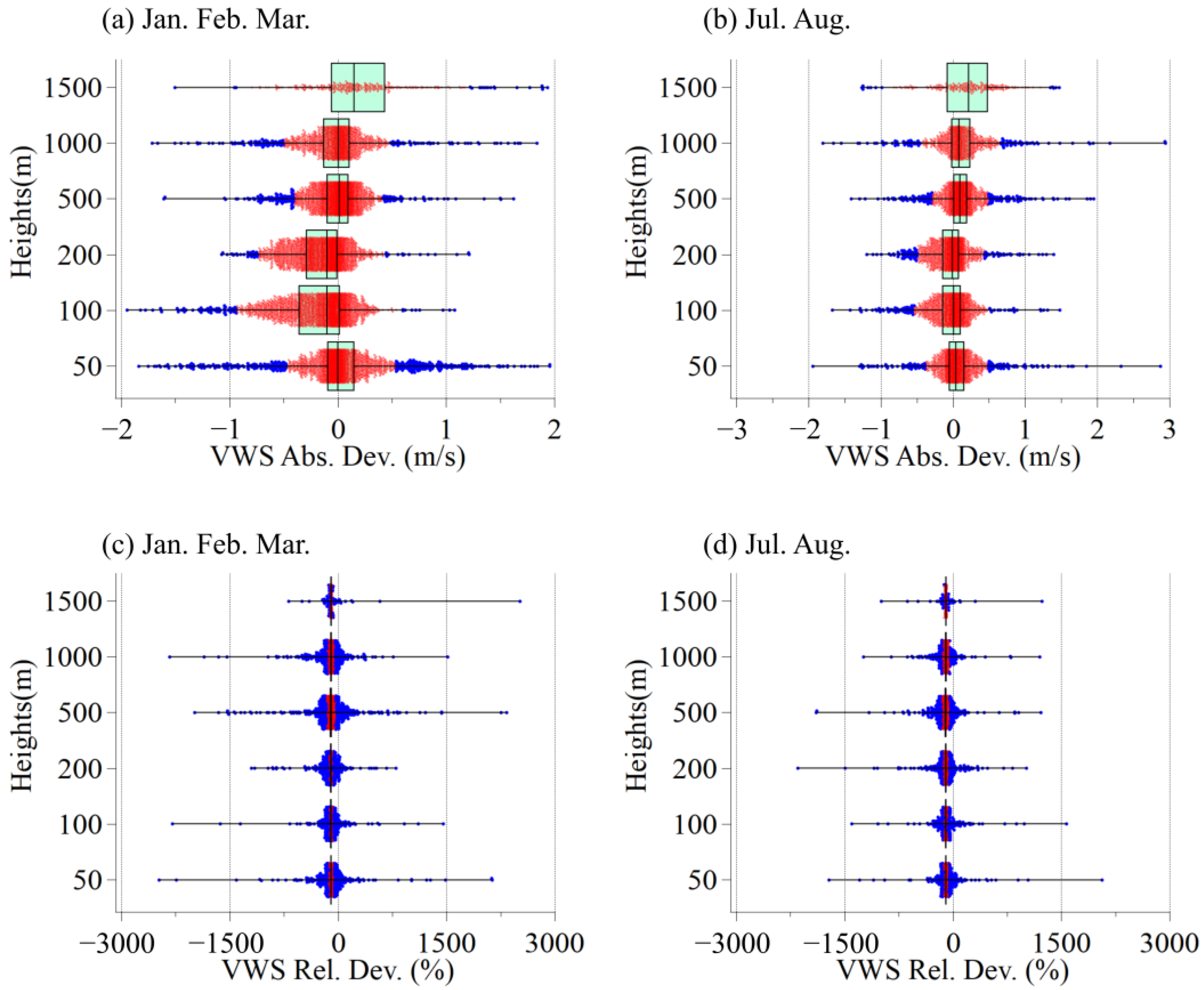
3.3. ERA5 Wind Assessment
3.4. ERA5 Temperature Assessment
3.5. ERA5 Relative Humidity Assessment
3.6. Comparison of ERA5 with Observed Meteorological Profile
3.7. Evaluation of ERA5 Boundary Layer Heights
4. Discussion
5. Conclusions
Supplementary Materials
Author Contributions
Funding
Data Availability Statement
Conflicts of Interest
References
- Stull, R.B. An Introduction to Boundary Layer Meteorology; Springer: Dordrecht, The Netherlands, 1988. [Google Scholar]
- Jia, W.; Zhang, X. The role of the planetary boundary layer parameterization schemes on the meteorological and aerosol pollution simulations: A review. Atmos. Res. 2020, 239, 104890. [Google Scholar] [CrossRef]
- Hersbach, H.; Dee, D. ERA5 Reanalysis is in Production, ECMWF News Letter, 2016; Volume 147, p. 7. Available online: https://www.ecmwf.int/en/newsletter/147/news/era5-reanalysis-production (accessed on 4 December 2024).
- Hersbach, H.; Bell, B.; Berrisford, P.; Hirahara, S.; Horányi, A.; Muñoz-Sabater, J.; Nicolas, J.; Peubey, C.; Radu, R.; Schepers, D.; et al. The ERA5 global reanalysis. Q. J. R. Meteorol. Soc. 2020, 146, 1999–2049. [Google Scholar] [CrossRef]
- Sleem, R.E.; Abdelfatah, M.A.; Mousa, A.E.K.; El-Fiky, G.S. A new Egyptian Grid Weighted Mean Temperature (EGWMT) model using hourly ERA5 reanalysis data in GNSS PWV retrieval. Sci. Rep. 2024, 14, 14608. [Google Scholar] [CrossRef] [PubMed]
- Wilczak, J.M.; Akish, E.; Capotondi, A.; Compo, G.P. Evaluation and Bias Correction of the ERA5 Reanalysis over the United States for Wind and Solar Energy Applications. Energies 2024, 17, 1667. [Google Scholar] [CrossRef]
- Cardoso, I.P.; Santiago, M.M.; Rodrigues, A.A.; Nunes, A.B. Validation of precipitation data generated by ERA5 reanalysis for the Mirim-São Gonçalo watershed, Brazil. Rev. Bras. Geogr. Física 2024, 17, 824–837. [Google Scholar] [CrossRef]
- Hanesiak, J.; Taszarek, M.; Walker, D.; Wang, C.C.; Betancourt, D. ERA5-based significant tornado environments in Canada between 1980 and 2020. J. Geophys. Res. Atmos. 2024, 129, e2023JD040614. [Google Scholar] [CrossRef]
- Jiang, Q.; Li, W.; Fan, Z.; He, X.; Sun, W.; Chen, S.; Wen, J.; Gao, J.; Wang, J. Evaluation of the ERA5 reanalysis precipitation dataset over Chinese Mainland. J. Hydrol. 2021, 595, 125660. [Google Scholar] [CrossRef]
- Jiao, D.; Xu, N.; Yang, F.; Xu, K. Evaluation of spatial-temporal variation performance of ERA5 precipitation data in China. Sci. Rep. 2021, 11, 17956. [Google Scholar] [CrossRef]
- Peng, K.; Xin, J.; Zhu, X.; Wang, X.; Cao, X.; Ma, Y.; Ren, X.; Zhao, D.; Cao, J.; Wang, Z. Machine learning model to accurately estimate the planetary boundary layer height of Beijing urban area with ERA5 data. Atmos. Res. 2023, 293, 106925. [Google Scholar] [CrossRef]
- Liu, H.; Dong, L.; Yan, R.; Zhang, X.; Guo, C.; Liang, S.; Tu, J.; Feng, X.; Wang, X. Evaluation of near-surface wind speed climatology and long-term trend over China’s mainland region based on ERA5 reanalysis. Clim. Environ. Res. 2021, 26, 299–311. [Google Scholar]
- Heitmann, K.; Sprenger, M.; Binder, H.; Wernli, H.; Joos, H. Warm conveyor belt characteristics and impacts along the life cycle of extratropical cyclones: Case studies and climatological analysis based on ERA5. EGUsphere 2023, 2023, 1–42. [Google Scholar] [CrossRef]
- Li, Z.; Mu, Z.; Gao, R. Applicability of ERA5 Reanalysis Precipitation Data in Runoff Modeling in China’s Ili River Basin. J. Hydrol. Eng. 2024, 29, 4024036. [Google Scholar] [CrossRef]
- Zhi, X.; Xu, H.-m. Comparative analysis of free atmospheric temperature between three reanalysis datasets and radiosonde dataset in China: Annual mean characteristic. Trans. Atmos. Sci. 2013, 36, 77–87. [Google Scholar]
- Yoshida, L.; Tomikawa, Y.; Ejiri, M.K.; Tsutsumi, M.; Kohma, M.; Sato, K. Large-amplitude inertia gravity waves over Syowa Station: Comparison of PANSY radar and ERA5 reanalysis data. J. Geophys. Res. Atmos. 2024, 129, e2023JD040490. [Google Scholar] [CrossRef]
- Graham, R.M.; Hudson, S.R.; Maturilli, M. Improved performance of ERA5 in Arctic gateway relative to four global atmospheric reanalyses. Geophys. Res. Lett. 2019, 46, 6138–6147. [Google Scholar] [CrossRef]
- Wei, Y.; Peng, K.; Ma, Y.; Sun, Y.; Zhao, D.; Ren, X.; Yang, S.; Ahmad, M.; Pan, X.; Wang, Z.; et al. Validation of ERA5 Boundary Layer Meteorological Variables by Remote-Sensing Measurements in the Southeast China Mountains. Remote Sens. 2024, 16, 548. [Google Scholar] [CrossRef]
- Yang, S.; Ma, Y.; Zhang, W.; Ren, X.; Peng, K.; Ahmad, M.; Jia, D.; Zhao, D.; Kong, L.; Ma, Y.; et al. High-Resolution Remote Sensing of the Gradient Richardson Number in a Megacity Boundary Layer. Remote Sens. 2024, 16, 1075. [Google Scholar] [CrossRef]
- Xin, J.; Peng, K.; Zhu, X.; Pan, X.; Wang, Q.; Cao, J.; Wang, Z.; Cap, X.; Ren, X.; Yang, S.; et al. AI model to improve the mountain boundary layer height of ERA5. Atmos. Res. 2024, 304, 107352. [Google Scholar] [CrossRef]
- Arruda Moreira, G.; Guerrero Rascado, J.L.; Bravo Aranda, J.A.; Foyo Moreno, I.; Cazorla, A.; Alados-Arboledas, I.; Lyamani, H.; Landulfo, E.; Alados Arboledas, L. Study of the planetary boundary layer height in an urban environment using a combination of microwave radiometer and ceilometer. Atmos. Res. 2020, 240, 104932. [Google Scholar] [CrossRef]
- Jiang, Y.; Xin, J.; Zhao, D.; Jia, D.; Tang, G.; Quan, J.; Wang, M.; Dai, L. Analysis of differences between thermodynamic and material boundary layer structure: Comparison of detection by ceilometer and microwave radiometer. Atmos. Res. 2021, 248, 105179. [Google Scholar] [CrossRef]
- Xin, Y.; Lu, N.; Jiang, H.; Liu, Y.; Yao, L. Performance of ERA5 reanalysis precipitation products in the Guangdong-Hong Kong-Macao greater bay area, China. J. Hydrol. 2021, 602, 126791. [Google Scholar] [CrossRef]
- Jia, D.; Xin, J.; Wang, Z.; Wang, W.; Wang, X.; Xiao, H.; Liu, C.; Zhou, J.; Tong, L.; Sun, Y.; et al. The dynamic, thermal and material structures of sea-land breeze circulation at the coastal of Ningbo, East China Sea. Atmos. Res. 2023, 283, 106540. [Google Scholar] [CrossRef]
- Ren, X.; Zhao, L.; Ma, Y.; Wu, J.; Zhou, F.; Jia, D.; Zhao, D.; Xin, J. Remote Sensing of Planetary Boundary Layer Thermodynamic and Material Structures over a Large Steel Plant, China. Remote Sens. 2023, 15, 5104. [Google Scholar] [CrossRef]
- Berg, L.K.; Newsom, R.K.; Turner, D.D. Year-long vertical velocity statistics derived from Doppler lidar data for the continental convective boundary layer. J. Appl. Meteorol. Climatol. 2017, 56, 2441–2454. [Google Scholar] [CrossRef]
- Chen, Y.; An, J.; Wang, X.; Sun, Y.; Wang, Z.; Duan, J. Observation of wind shear during evening transition and an estimation of submicron aerosol concentrations in Beijing using a Doppler wind lidar. J. Meteorol. Res. 2017, 31, 350–362. [Google Scholar] [CrossRef]
- Kumer, V.M.; Reuder, J.; Furevik, B.R. A comparison of LiDAR and radiosonde wind measurements. Energy Procedia 2014, 53, 214–220. [Google Scholar] [CrossRef]
- Dai, L.; Xin, J.; Zuo, H.; Ma, Y.; Zhang, L.; Wu, X.; Ma, Y.; Jia, D.; Wu, F. Multilevel validation of Doppler Wind lidar by the 325 m meteorological tower in the planetary boundary layer of Beijing. Atmosphere 2020, 11, 1051. [Google Scholar] [CrossRef]
- Aitken, M.L.; Rhodes, M.E.; Lundquist, J.K. Performance of a wind-profiling lidar in the region of wind turbine rotor disks. J. Atmos. Ocean. Technol. 2012, 29, 347–355. [Google Scholar] [CrossRef]
- Gryning, S.E.; Floors, R. Carrier-to-noise-threshold filtering on off-shore wind lidar measurements. Sensors 2019, 19, 592. [Google Scholar] [CrossRef]
- Cimini, T.; Hewison, T.; Martin, L.; Güldner, J.; Gaffard, C.; Marzano, F.S. Temperature and humidity profile retrievals from ground-based microwave radiometers during TUC. Meteorol. Z. 2006, 15, 45–56. [Google Scholar] [CrossRef]
- Vishwakarma, P.; Delanoë, J.; Jorquera, S.; Martinet, P.; Burnet, F.; Bell, A.; Dupont, J.C. Climatology of estimated liquid water content and scaling factor for warm clouds using radar–microwave radiometer synergy. Atmos. Meas. Tech. 2023, 16, 1211–1237. [Google Scholar] [CrossRef]
- Martinet, P.; Cimini, D.; Burnet, F.; Ménétrier, B.; Michel, Y.; Unger, V. Improvement of numerical weather prediction model analysis during fog conditions through the assimilation of ground-based microwave radiometer observations: A 1D-Var study. Atmos. Meas. Tech. 2020, 13, 6593–6611. [Google Scholar] [CrossRef]
- Löhnert, U.; Maier, O. Operational profiling of temperature using ground-based microwave radiometry at Payerne: Prospects and challenges. Atmos. Meas. Tech. 2012, 5, 1121–1134. [Google Scholar] [CrossRef]
- Sorteberg, A.; Kattsov, V.; Walsh, J.E.; Pavlova, T. The Arctic surface energy budget as simulated with the IPCC AR4 AOGCMs. Clim. Dyn. 2007, 29, 131–156. [Google Scholar] [CrossRef]
- Tjernström, M.; Graversen, R.G. The vertical structure of the lower Arctic troposphere analysed from observations and the ERA-40 reanalysis. Q. J. R. Meteorol. Soc. 2009, 135, 431–443. [Google Scholar] [CrossRef]
- Jakobson, E.; Vihma, T.; Palo, T.; Jakobson, L.; Keernik, H.; Jaagus, J. Validation of atmospheric reanalyses over the central Arctic Ocean. Geophys. Res. Lett. 2012, 39, L10802. [Google Scholar] [CrossRef]
- Lindsay, R.; Wensnahan, M.; Schweiger, A.; Zhang, J. Evaluation of seven different atmospheric reanalysis products in the Arctic. J. Clim. 2014, 27, 2588–2606. [Google Scholar] [CrossRef]
- Holzworth, G.C. Estimates of mean maximum mixing depths in the contiguous United States. Mon. Weather. Rev. 1964, 92, 235–242. [Google Scholar] [CrossRef]
- Collaud Coen, M.; Praz, C.; Haefele, A.; Ruffieux, D.; Kaufmann, P.; Calpini, B. Determination and climatology of the planetary boundary layer height above the Swiss plateau by in situ and remote sensing measurements as well as by the COSMO-2 model. Atmos. Chem. Phys. 2014, 14, 13205–13221. [Google Scholar] [CrossRef]
- De Wekker, S.F.; Kossmann, M. Convective boundary layer heights over mountainous terrain—A review of concepts. Front. Earth Sci. 2015, 3, 77. [Google Scholar] [CrossRef]
- Huang, X.; Wang, Z.; Ding, A. Impact of aerosol-PBL interaction on haze pollution: Multiyear observational evidences in North China. Geophys. Res. Lett. 2018, 45, 8596–8603. [Google Scholar] [CrossRef]
- Zängl, G.; Hornsteiner, M. The exceptional Alpine south föhn event of 14–16 November 2002: A case study. Meteorol. Atmos. Phys. 2007, 98, 217–238. [Google Scholar] [CrossRef]
- Ma, Y.; Ye, J.; Xin, J.; Zhang, W.; Vil-Guerau de Arellano, J.; Wang, S.; Zhao, D.; Dai, L.; Ma, Y.; Wu, X. The stove, dome, and umbrella effects of atmospheric aerosol on the development of the planetary boundary layer in hazy regions. Geophys. Res. Lett. 2020, 47, e2020GL087373. [Google Scholar] [CrossRef]
- Gohm, A.; Harnisch, F.; Vergeiner, J.; Obleitner, F.; Schnitzhofer, R.; Hansel, A.; Fix, A.; Neininger, B.; Emeis, S.; Schäfer, K. Air pollution transport in an Alpine valley: Results from airborne and ground-based observations. Bound. Layer Meteorol. 2009, 131, 441–463. [Google Scholar] [CrossRef]
- Bianco, L.; Djalalova, I.V.; King, C.W.; Wilczak, J.M. Diurnal evolution and annual variability of boundary-layer height and its correlation to other meteorological variables in California’s Central Valley. Bound. Layer Meteorol. 2011, 140, 491–511. [Google Scholar] [CrossRef]
- Lee, X.; Gao, Z.; Zhang, C.; Chen, F.; Hu, Y.; Jiang, W.; Liu, S.; Lu, L.; Sun, J.; Wang, J.; et al. Priorities for boundary layer meteorology research in China. Bull. Am. Meteorol. Soc. 2015, 96, ES149–ES151. [Google Scholar] [CrossRef]
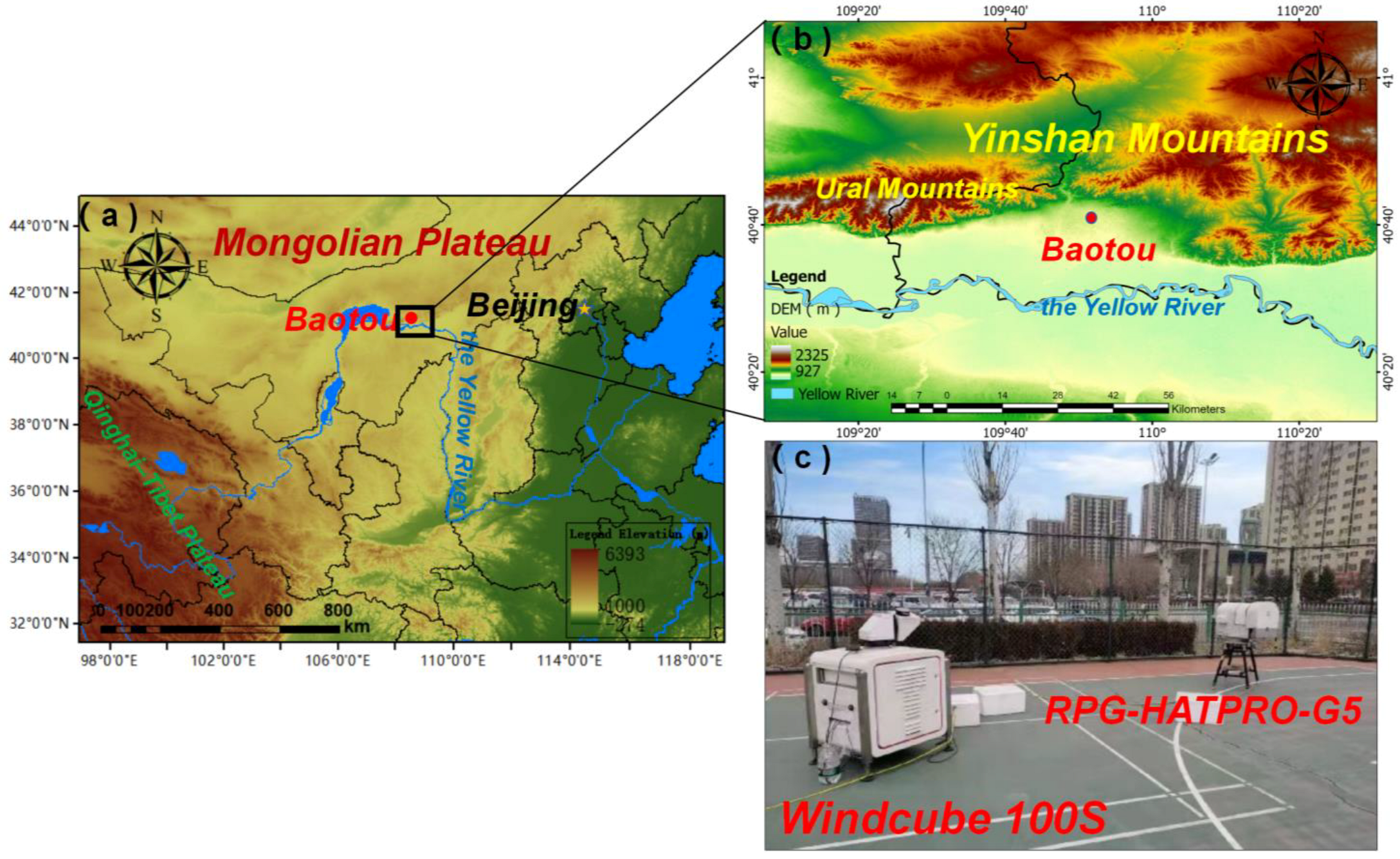
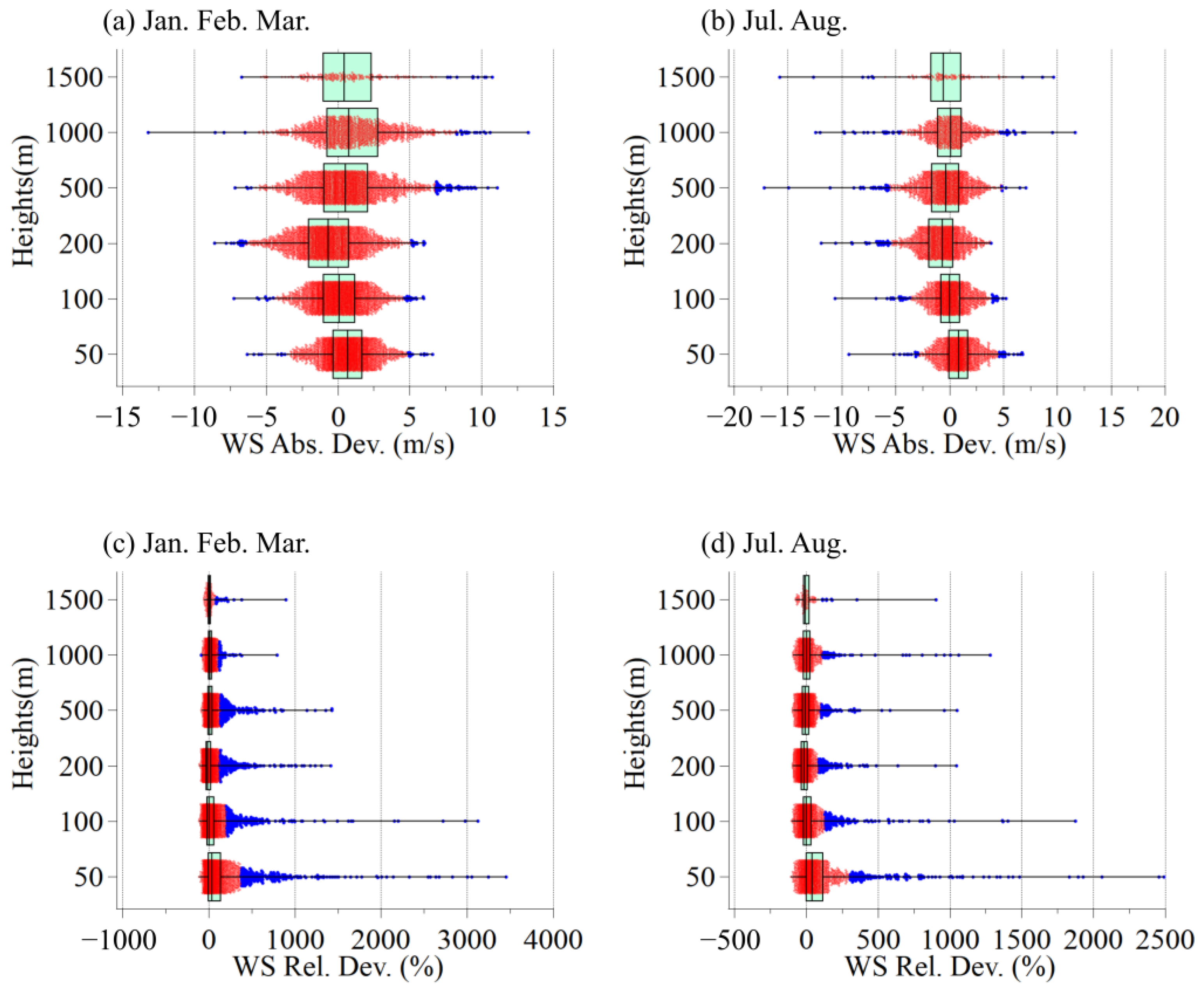
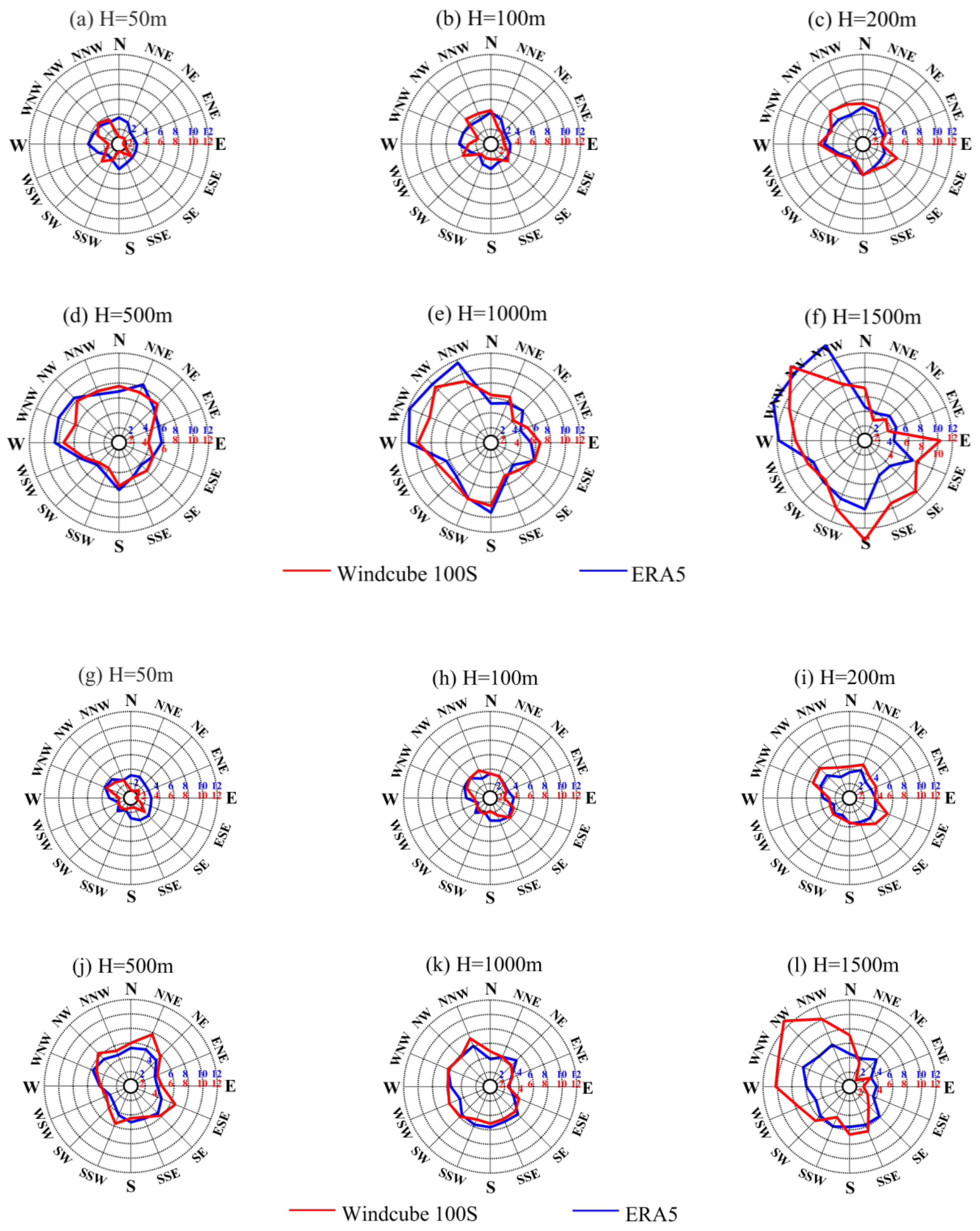

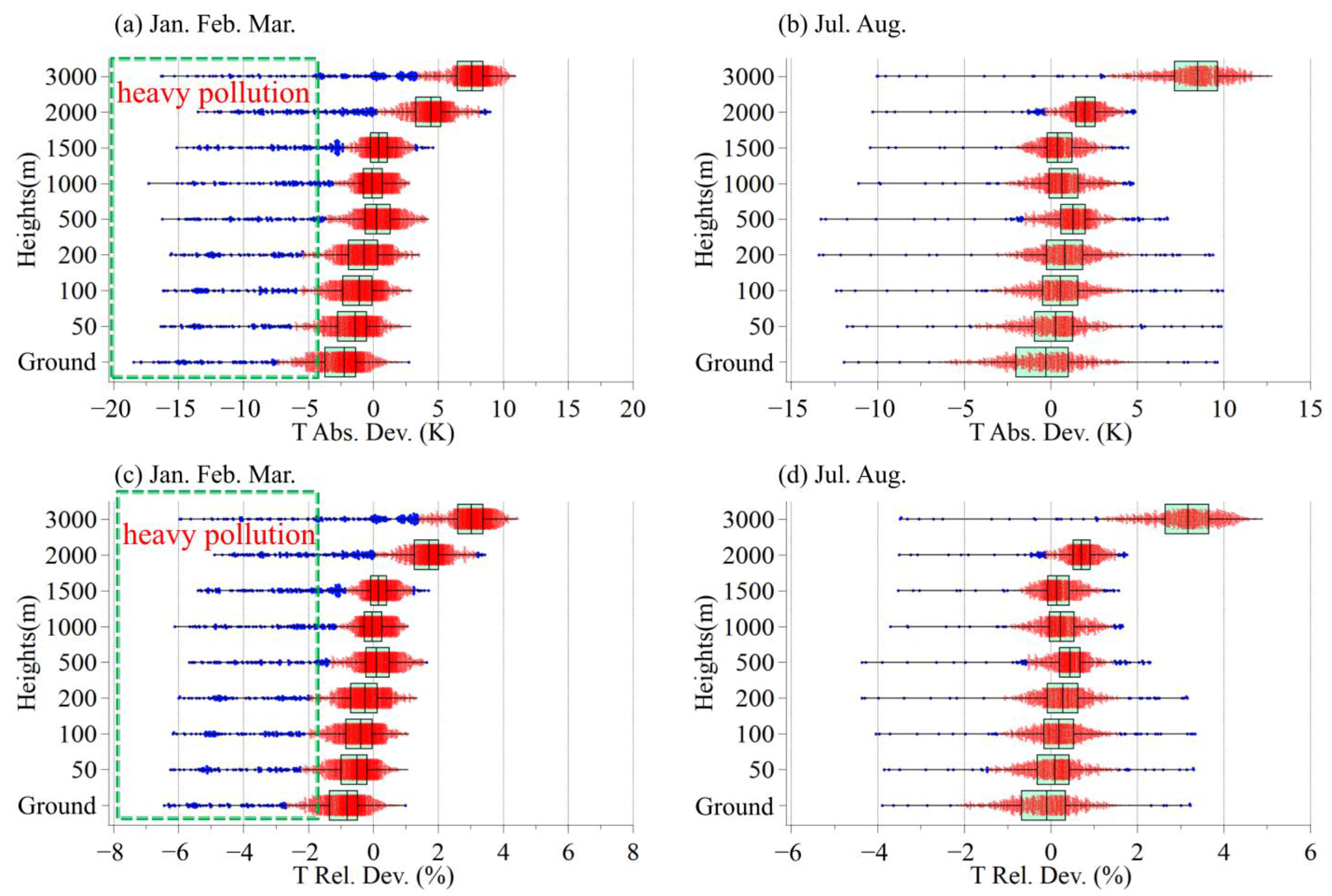
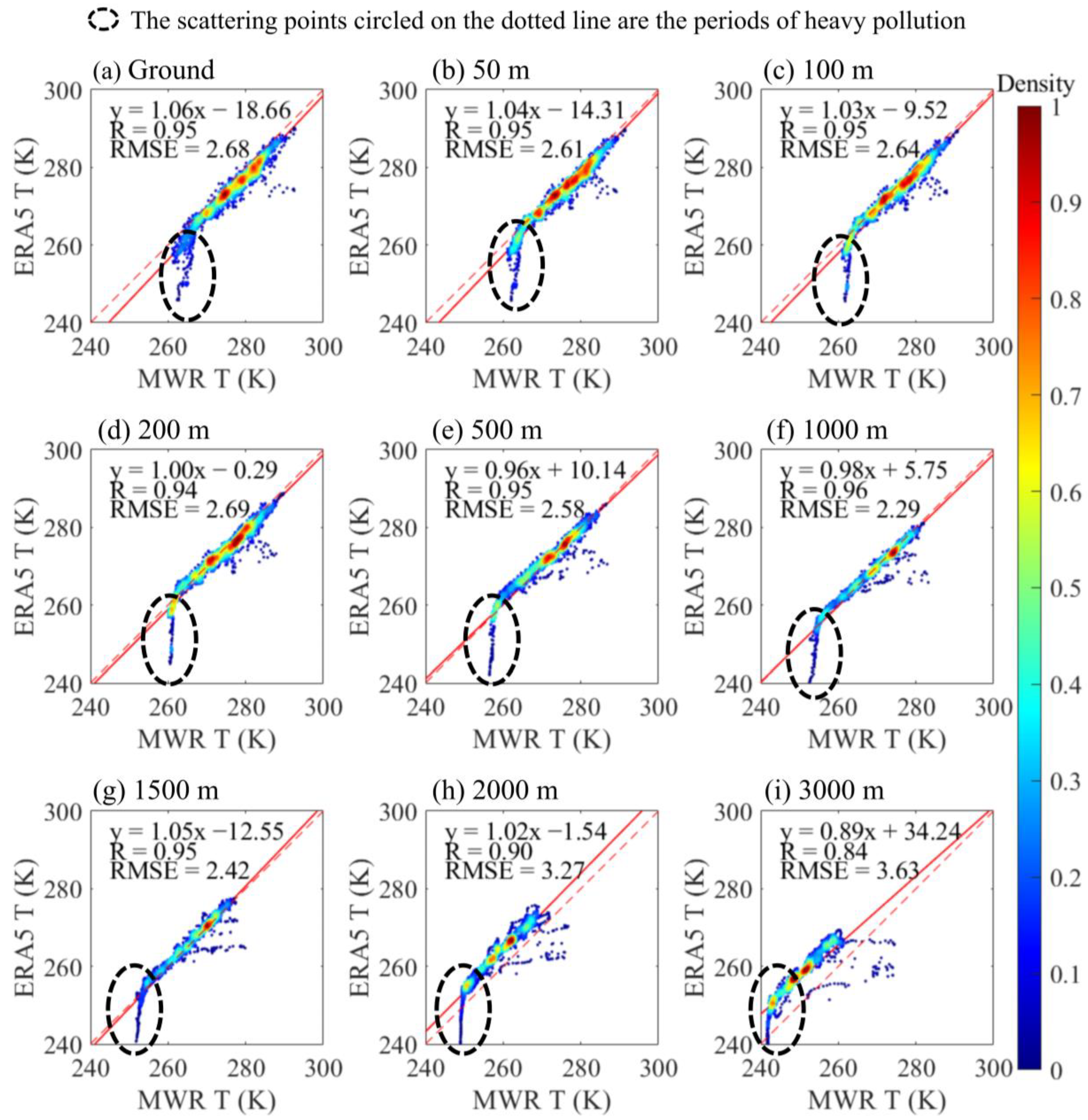
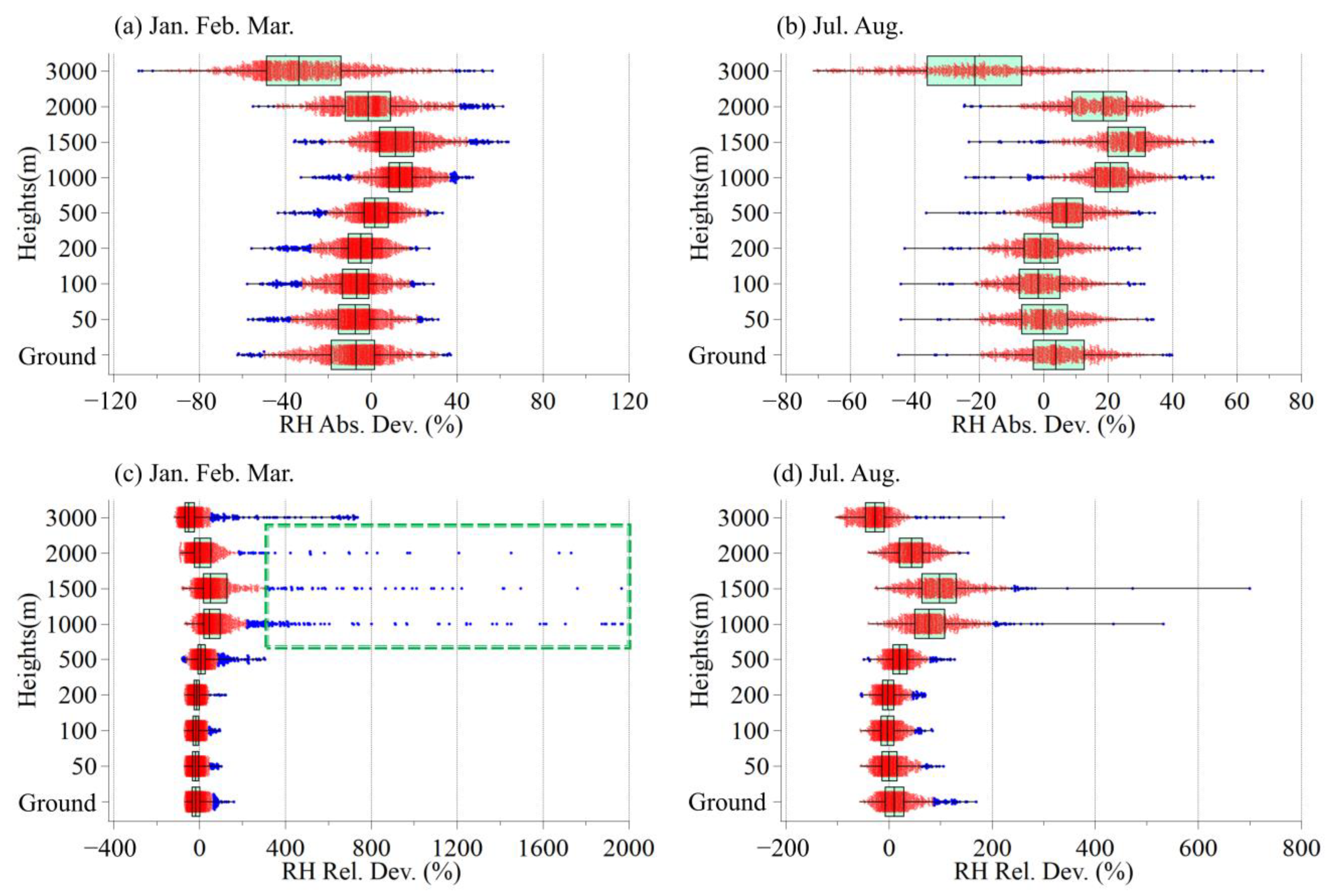
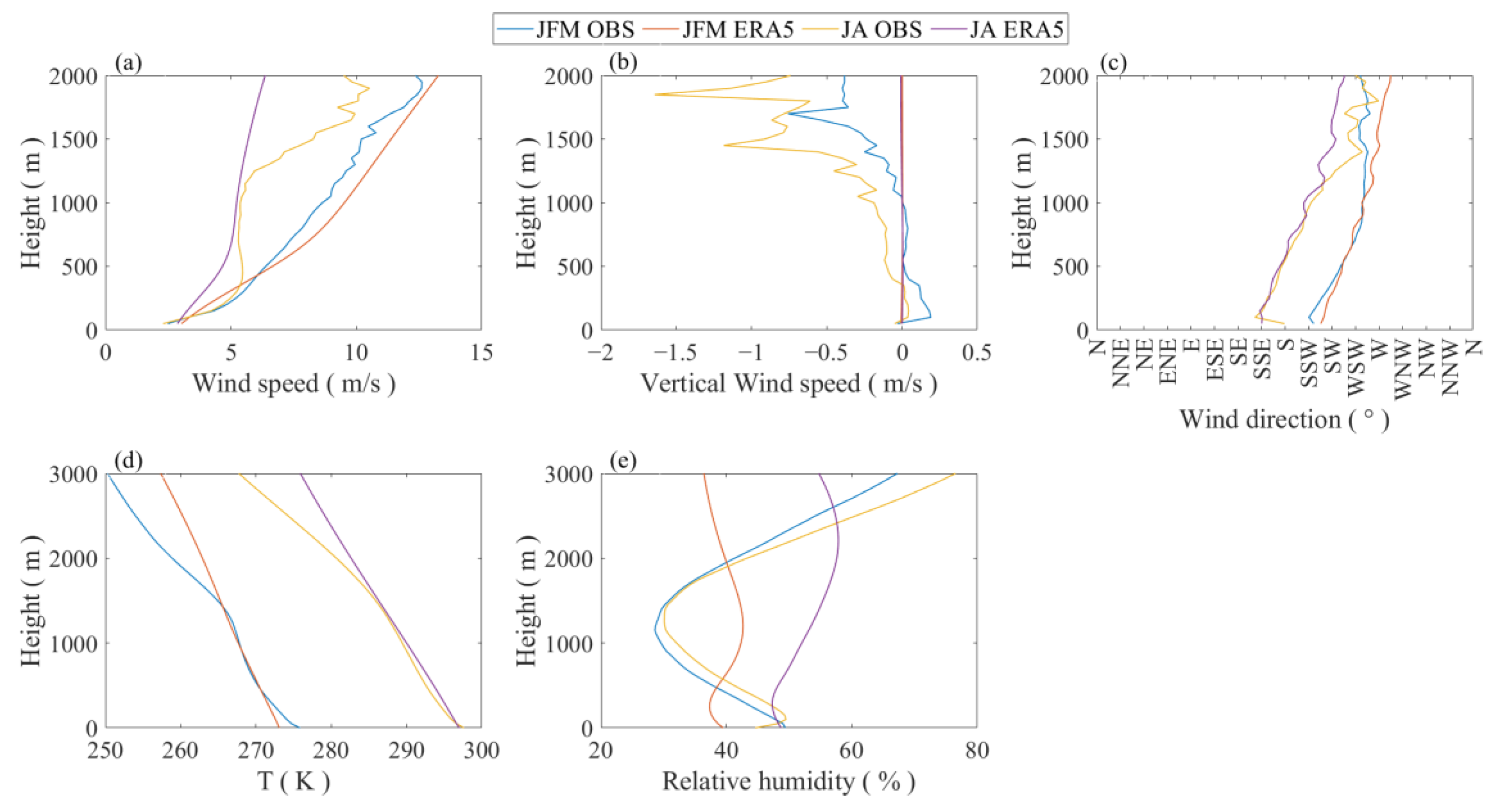
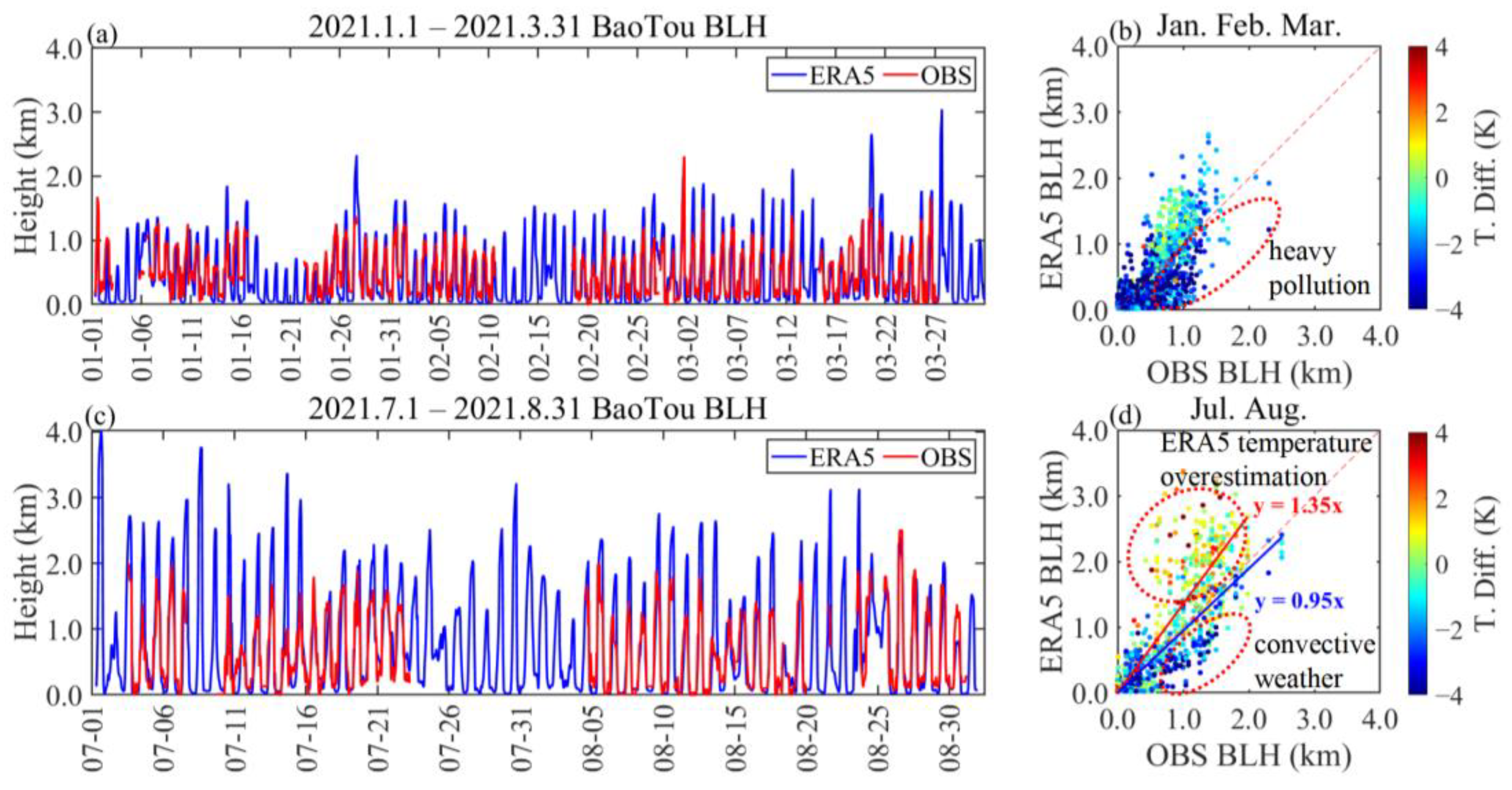
Disclaimer/Publisher’s Note: The statements, opinions and data contained in all publications are solely those of the individual author(s) and contributor(s) and not of MDPI and/or the editor(s). MDPI and/or the editor(s) disclaim responsibility for any injury to people or property resulting from any ideas, methods, instructions or products referred to in the content. |
© 2025 by the authors. Licensee MDPI, Basel, Switzerland. This article is an open access article distributed under the terms and conditions of the Creative Commons Attribution (CC BY) license (https://creativecommons.org/licenses/by/4.0/).
Share and Cite
Wei, Y.; Sun, Y.; Ma, Y.; Tan, Y.; Ren, X.; Peng, K.; Yang, S.; Lin, Z.; Zhou, X.; Ren, Y.; et al. Deviations of Boundary Layer Height and Meteorological Parameters Between Ground-Based Remote Sensing and ERA5 over the Complex Terrain of the Mongolian Plateau. Remote Sens. 2025, 17, 393. https://doi.org/10.3390/rs17030393
Wei Y, Sun Y, Ma Y, Tan Y, Ren X, Peng K, Yang S, Lin Z, Zhou X, Ren Y, et al. Deviations of Boundary Layer Height and Meteorological Parameters Between Ground-Based Remote Sensing and ERA5 over the Complex Terrain of the Mongolian Plateau. Remote Sensing. 2025; 17(3):393. https://doi.org/10.3390/rs17030393
Chicago/Turabian StyleWei, Yiming, Yankun Sun, Yongjing Ma, Yulong Tan, Xinbing Ren, Kecheng Peng, Simin Yang, Zhong Lin, Xingjun Zhou, Yuanzhe Ren, and et al. 2025. "Deviations of Boundary Layer Height and Meteorological Parameters Between Ground-Based Remote Sensing and ERA5 over the Complex Terrain of the Mongolian Plateau" Remote Sensing 17, no. 3: 393. https://doi.org/10.3390/rs17030393
APA StyleWei, Y., Sun, Y., Ma, Y., Tan, Y., Ren, X., Peng, K., Yang, S., Lin, Z., Zhou, X., Ren, Y., Ahmed, M., Tian, Y., & Xin, J. (2025). Deviations of Boundary Layer Height and Meteorological Parameters Between Ground-Based Remote Sensing and ERA5 over the Complex Terrain of the Mongolian Plateau. Remote Sensing, 17(3), 393. https://doi.org/10.3390/rs17030393







